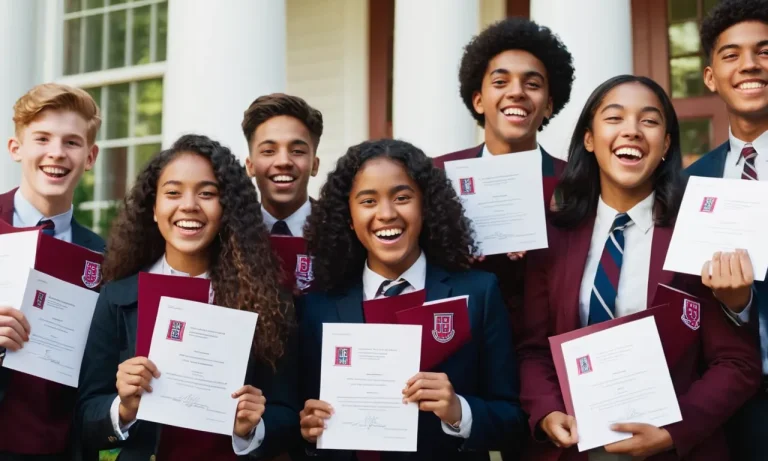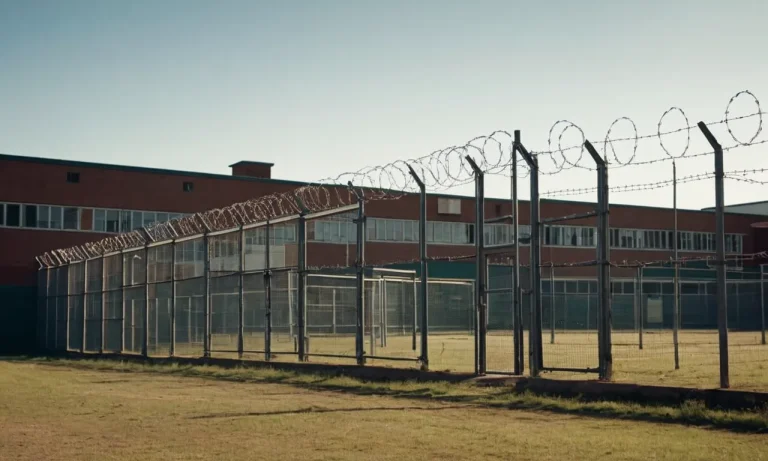In the digital age, internet access has become an integral part of our daily lives, including in educational settings. However, many students often find themselves frustrated by the restrictive internet policies implemented by their schools, which seem to block access to a wide range of websites and online resources.
This begs the question: why does school block everything?
If you’re short on time, here’s a quick answer to your question: Schools block certain websites and online content primarily for security, legal, and educational reasons. They aim to protect students from potential online threats, comply with regulations, and maintain a focused learning environment.
In this comprehensive article, we will delve into the various factors that contribute to schools’ internet filtering policies. We will explore the rationale behind these restrictions, the challenges they pose, and potential solutions or alternatives.
By understanding the motivations and considerations behind these measures, we can gain a better appreciation for the complexities involved in managing internet access in educational settings.
Ensuring Student Safety and Security
In the digital age, schools face the daunting challenge of protecting their students from the perils of the online world. The decision to block certain websites and online content stems from a deep commitment to safeguarding the well-being and security of every student.
By implementing robust filtering measures, educational institutions aim to create a safe and nurturing environment conducive to learning and personal growth.
Protecting students from online threats
The internet, while a vast repository of knowledge, can also harbor malicious actors and dangerous content. Schools recognize the need to shield their students from online threats such as phishing scams, malware, and other cyber attacks that could compromise sensitive information or compromise the security of their networks.
According to a report by the K12 Cybersecurity Resource Center, there were over 1,600 publicly disclosed cybersecurity incidents affecting K-12 schools in 2022 alone. By blocking access to suspicious or known malicious websites, schools proactively mitigate these risks, ensuring a secure digital environment for their students.
Preventing cyberbullying and harassment
Cyberbullying and online harassment have emerged as significant concerns in the digital age, with far-reaching consequences for students’ mental health and overall well-being. According to a study by the U.S.
Department of Health and Human Services, approximately 20% of students aged 12-18 experienced cyberbullying in 2021. By restricting access to certain social media platforms and online forums, schools aim to create a safe haven where students can focus on their studies without fear of harassment or bullying.
😊 This proactive approach helps foster a positive and inclusive learning environment, promoting emotional well-being and academic success.
Mitigating exposure to inappropriate content
The internet is a vast and unregulated space, where inappropriate or explicit content can easily find its way into the hands of unsuspecting students. Schools have a responsibility to shield their students from exposure to such content, which can potentially harm their emotional and psychological development.
By blocking access to websites containing explicit or age-inappropriate material, schools create a safe and age-appropriate digital environment for their students. This not only protects their innocence but also aligns with the educational institution’s values and commitment to providing a nurturing learning environment.
While the decision to block certain websites and online content may seem restrictive, it is a necessary measure to ensure the safety and security of students in the digital age. By proactively addressing online threats, preventing cyberbullying and harassment, and mitigating exposure to inappropriate content, schools create a secure and nurturing environment where students can thrive academically and personally.
Ultimately, the goal is to strike a balance between providing access to educational resources and protecting students from potential harm, fostering a positive and productive learning experience for all.
Legal and Regulatory Compliance
Schools have a legal obligation to ensure a safe online environment for students. By blocking certain websites and online content, they aim to adhere to various internet safety laws and regulations designed to protect minors from potential harm.
This proactive approach helps schools mitigate risks and maintain compliance.
Adherence to internet safety laws and regulations
Several laws and regulations govern internet safety for minors, such as the Children’s Online Privacy Protection Act (COPPA) and the Children’s Internet Protection Act (CIPA). COPPA imposes restrictions on the collection and use of personal information from children under 13, while CIPA requires schools to implement internet safety policies and technology protection measures to receive federal funding for internet access.
By blocking access to certain websites and online content, schools demonstrate their commitment to upholding these laws and protecting students’ online privacy and safety.
Compliance with copyright and intellectual property laws
Schools also have a responsibility to respect and comply with copyright and intellectual property laws. By restricting access to websites that facilitate illegal downloading or sharing of copyrighted materials, such as movies, music, and software, schools aim to prevent potential copyright infringement and associated legal consequences.
According to a study by ResearchAndMarkets.com, the global cost of copyright and IP infringement is projected to reach $1.54 trillion by 2026, highlighting the importance of compliance in this area.
Avoiding potential legal liabilities
By implementing content filtering and website blocking measures, schools can mitigate potential legal liabilities arising from inappropriate or harmful online activities conducted on their networks. This proactive approach helps schools maintain a safe and secure online environment, reducing the risk of lawsuits or legal action related to cyberbullying, harassment, or exposure to explicit or offensive content.
According to a survey by Education Week, 93% of school leaders reported taking measures to prevent cyberbullying, underscoring the importance of addressing online safety concerns.
While website blocking may seem restrictive, it’s a crucial step for schools to fulfill their legal and regulatory obligations, protect students’ well-being, and maintain a positive and secure online learning environment.
By staying compliant and proactive, schools can foster a safer digital space for students to learn and grow 🌟.
Maintaining a Focused Learning Environment
Schools often block certain websites and online content to create a focused learning environment for students. This approach aims to minimize distractions and promote productivity by restricting access to non-educational or potentially harmful content.
By limiting online distractions, schools hope to foster an atmosphere conducive to learning and academic growth.
Minimizing distractions and promoting productivity
In today’s digital age, where students are constantly bombarded with social media, gaming platforms, and various entertainment websites, it can be challenging to maintain focus and concentration during class hours.
According to a study by EdWeek, 92% of teachers believe that digital technologies are a distraction in their classrooms. By blocking access to non-educational websites, schools aim to eliminate these potential distractions, enabling students to stay engaged and productive during instructional time.
Prioritizing educational resources and content
Schools often implement content filtering measures to ensure that students have access to educational resources and content that align with the curriculum and learning objectives. This approach helps to prioritize credible and age-appropriate information sources, preventing exposure to inappropriate or unreliable content.
According to Common Sense Media, 59% of parents are concerned about their children’s exposure to inappropriate online content. By curating the available online resources, schools can provide a safer and more focused learning environment.
Fostering responsible internet usage habits
Blocking certain websites and online content can also serve as a valuable lesson in responsible internet usage. By experiencing the limitations and boundaries set by the school’s content filtering system, students learn to navigate the online world more mindfully.
This experience can foster responsible internet usage habits that extend beyond the classroom, preparing students for the digital challenges they may face in their future academic and professional endeavors.
A study by Pew Research Center found that 45% of teens feel overwhelmed by the amount of online content they encounter. By teaching responsible internet usage, schools can help students develop the skills to navigate the digital landscape more effectively.
Challenges and Potential Solutions
Balancing security and access to educational resources
Striking the right balance between network security and providing access to educational resources is a delicate dance for schools. On one hand, they need to safeguard students from potential online threats, such as malware, inappropriate content, and cyberbullying.
On the other hand, overly restrictive filtering policies can hinder students’ ability to access valuable educational materials and digital tools essential for their learning and development.
According to a study by the American Library Association, a staggering 78% of schools reported blocking access to legitimate educational websites, inadvertently limiting students’ exposure to valuable resources.
To address this challenge, schools must adopt a balanced approach, implementing robust security measures while ensuring that students can access age-appropriate and curriculum-relevant content.
Implementing flexible and adaptive filtering policies
One potential solution lies in implementing flexible and adaptive filtering policies that can be tailored to different grade levels, subject areas, and educational needs. Instead of a one-size-fits-all approach, schools could adopt a more nuanced approach that allows for greater flexibility based on the specific context and requirements of each class or subject.
For instance, Cisco’s Umbrella offers a comprehensive solution that allows schools to create custom policies, enabling them to block specific categories of websites while whitelisting educational resources.
Additionally, it provides real-time content analysis and dynamic content filtering, ensuring that students have access to the most up-to-date and relevant materials while maintaining a safe online environment.
Exploring alternative approaches and technologies
While traditional web filtering technologies have their merits, schools may also consider exploring alternative approaches and emerging technologies to strike a better balance between security and access.
For example, cloud-based content filtering solutions can offer more granular control and real-time updates, ensuring that students have access to the latest educational resources while mitigating potential risks.
Furthermore, the rise of virtual learning environments and remote learning platforms has opened up new avenues for delivering educational content in a controlled and secure manner. Schools could leverage these platforms to curate and distribute approved educational materials, minimizing the need for overly restrictive web filtering policies.
😊
Ultimately, the challenges surrounding school web filtering require a multifaceted approach that involves collaboration between educators, IT professionals, and policymakers. By embracing innovative technologies, adopting flexible policies, and fostering open dialogue, schools can create a safe and enriching online environment that nurtures student learning and growth.
It’s a delicate balance, but one that is crucial for preparing students for success in our increasingly digital world.
Conclusion
The decision to block certain websites and online content in schools is a complex issue that involves balancing various priorities, including student safety, legal compliance, and maintaining a focused learning environment.
While these measures may seem restrictive to students, they are implemented with the intention of protecting them and fostering a productive educational setting.
As technology continues to evolve and our reliance on the internet grows, it is crucial for schools to regularly review and adapt their internet filtering policies. By engaging with stakeholders, exploring alternative approaches, and leveraging emerging technologies, schools can strive to strike a balance between ensuring a safe and secure online environment while providing students with access to valuable educational resources.
Ultimately, the goal should be to empower students with the knowledge and skills necessary to navigate the digital world responsibly, while also safeguarding their well-being and promoting an environment conducive to learning and personal growth.






